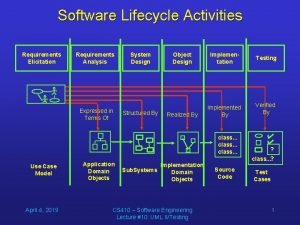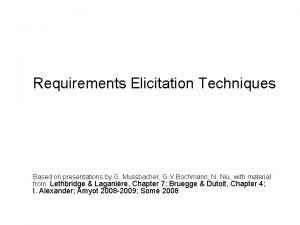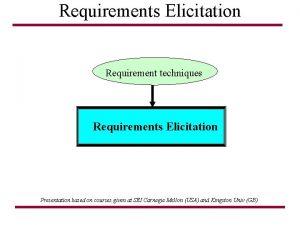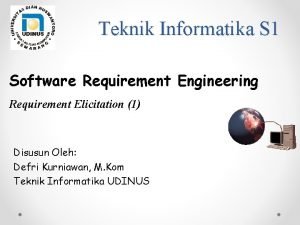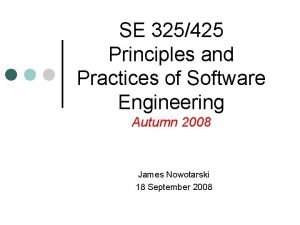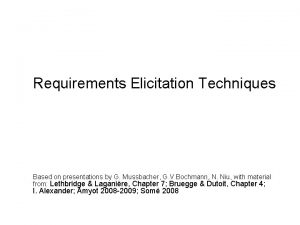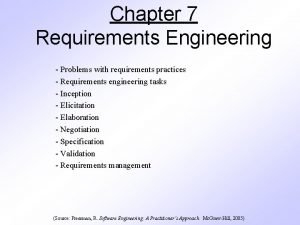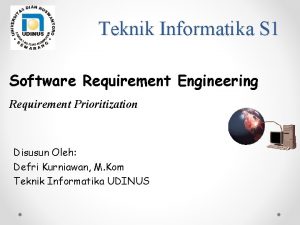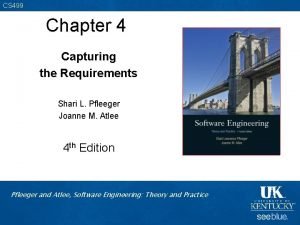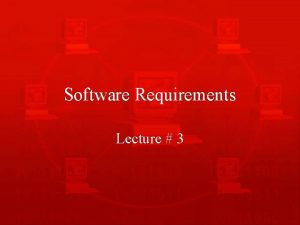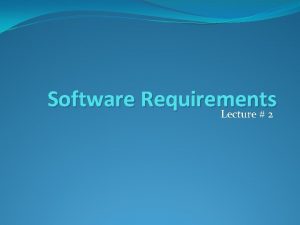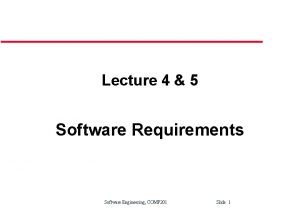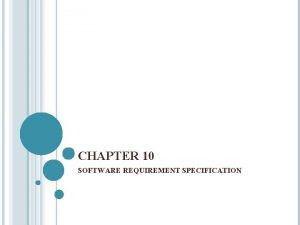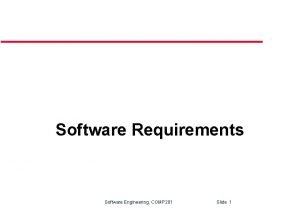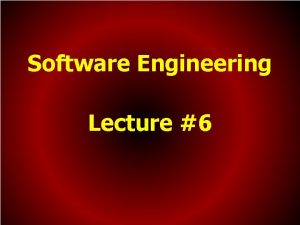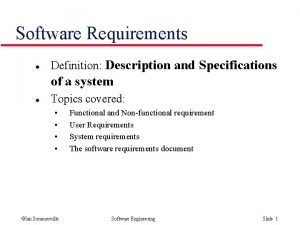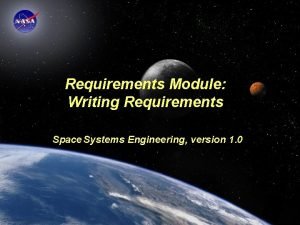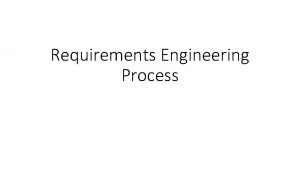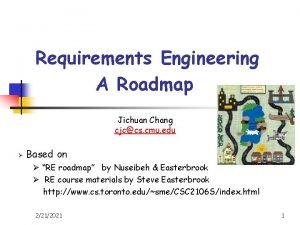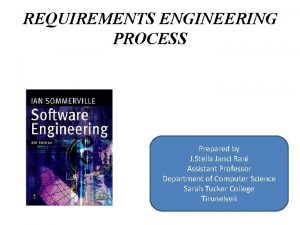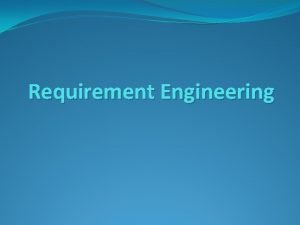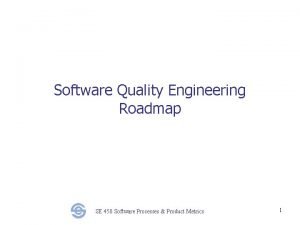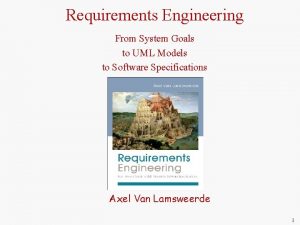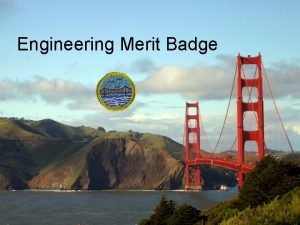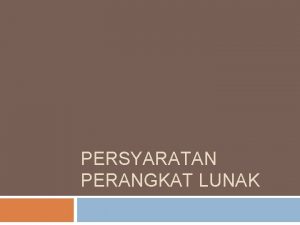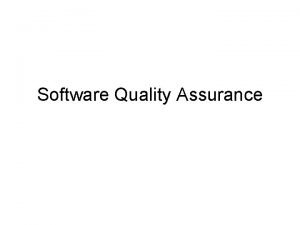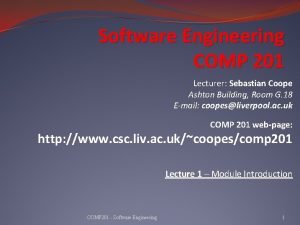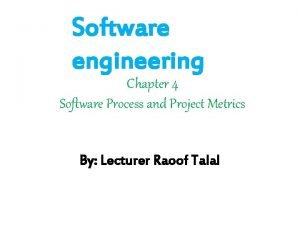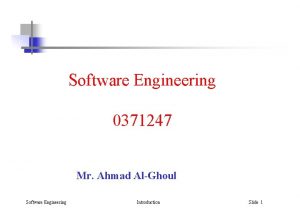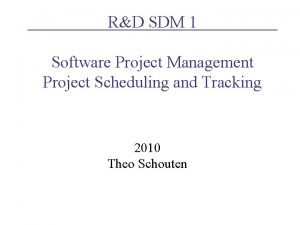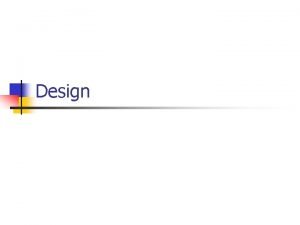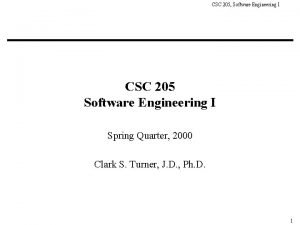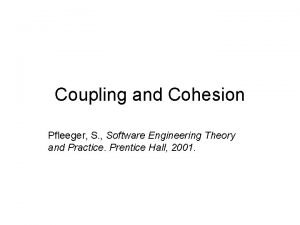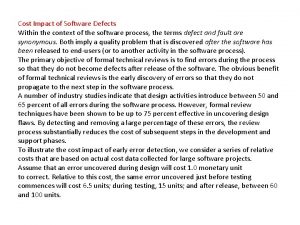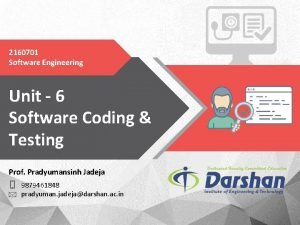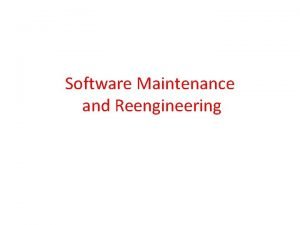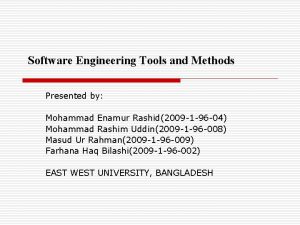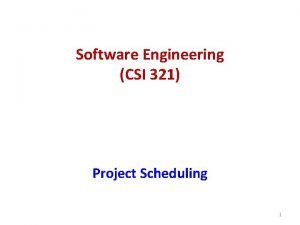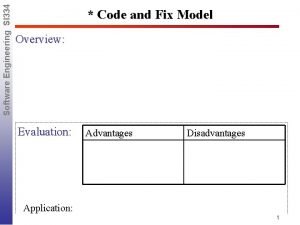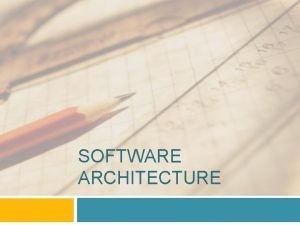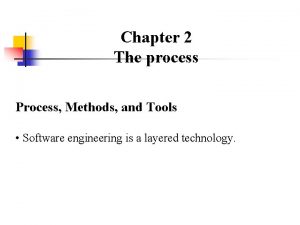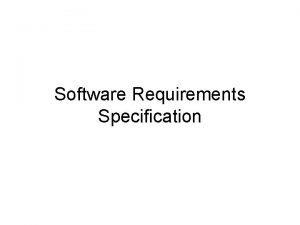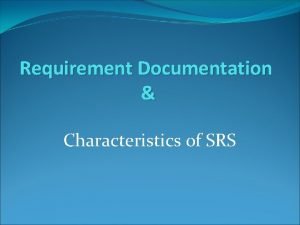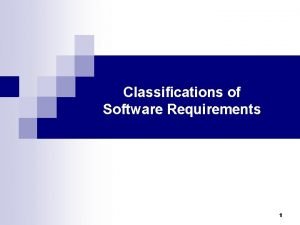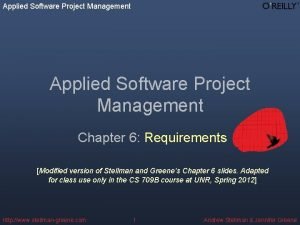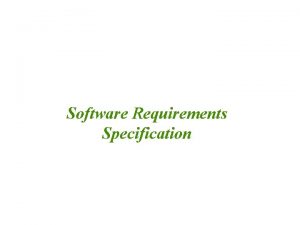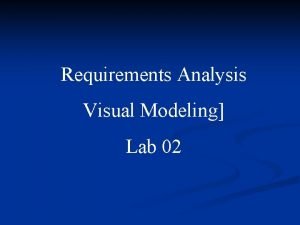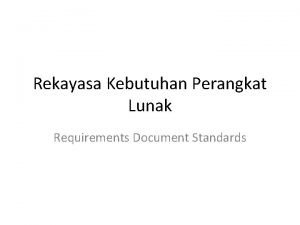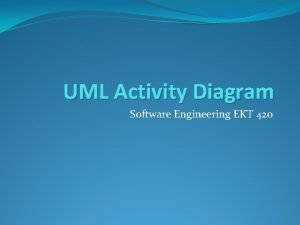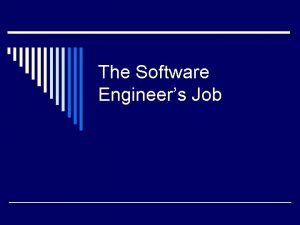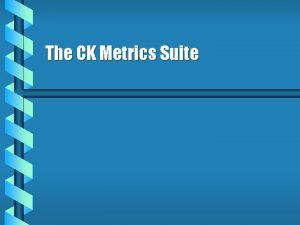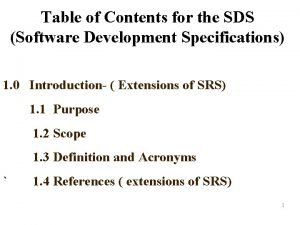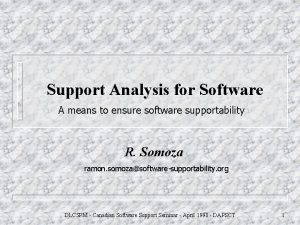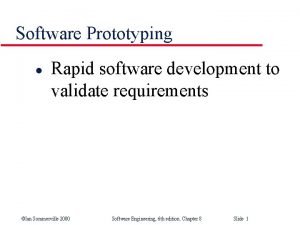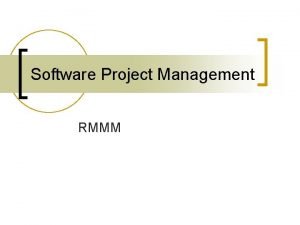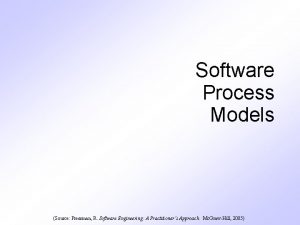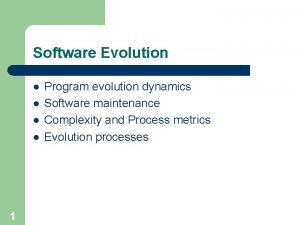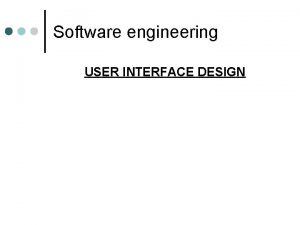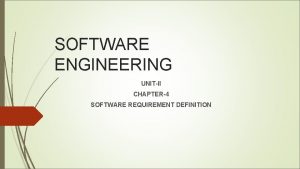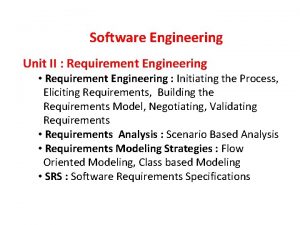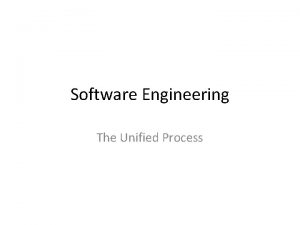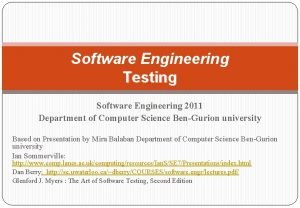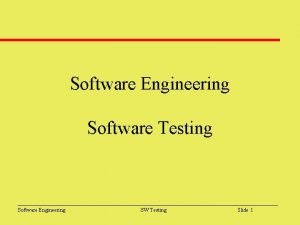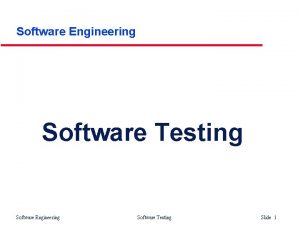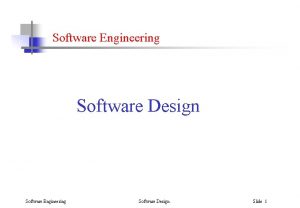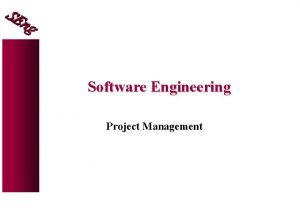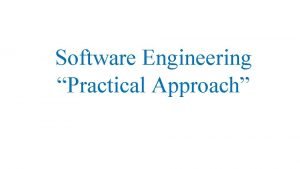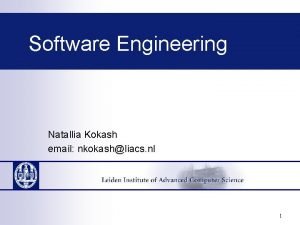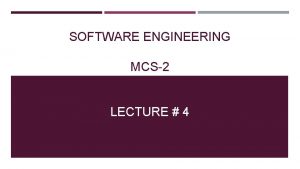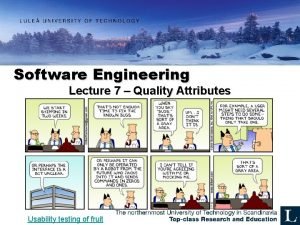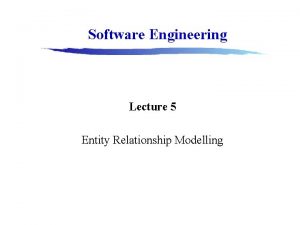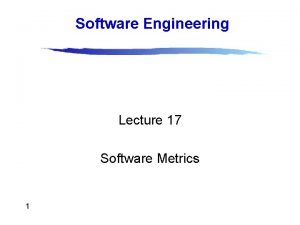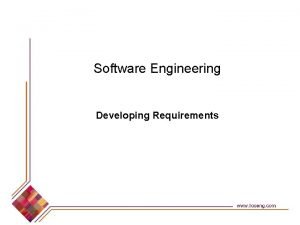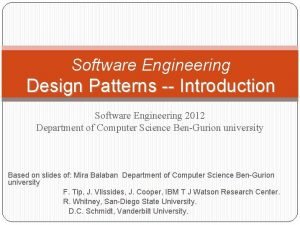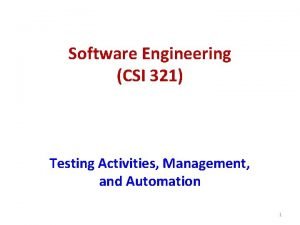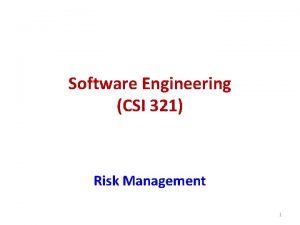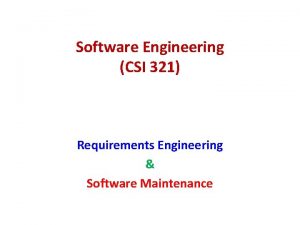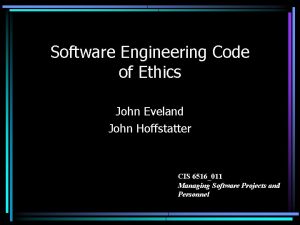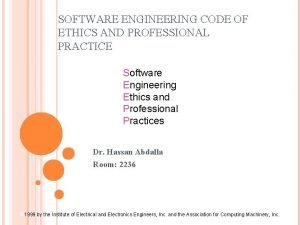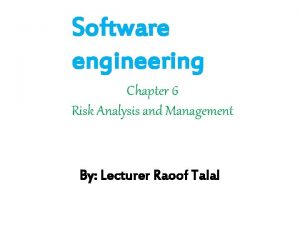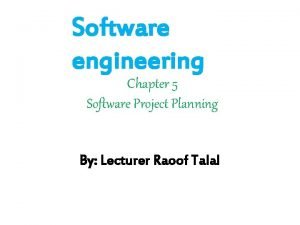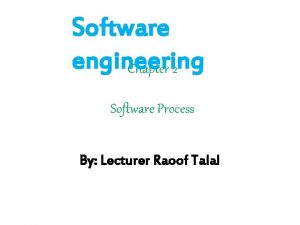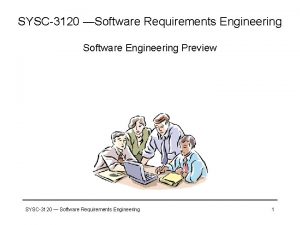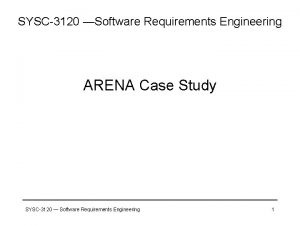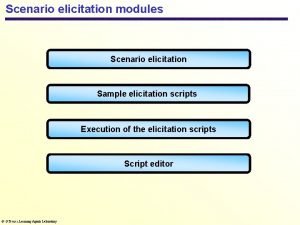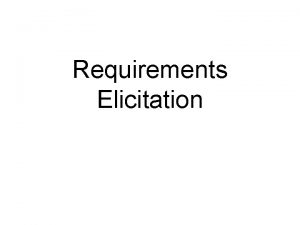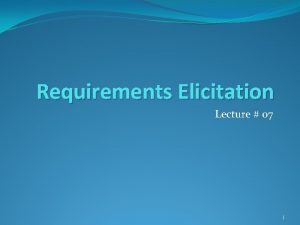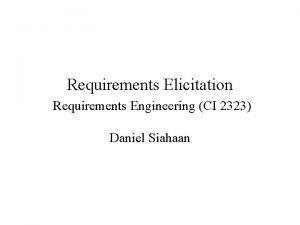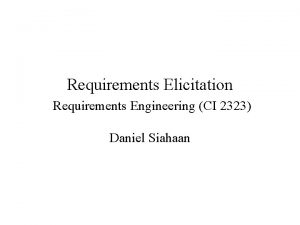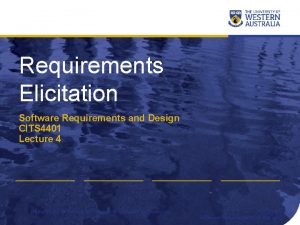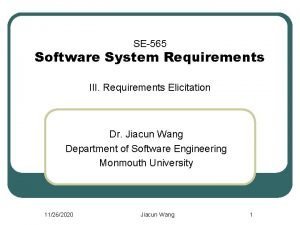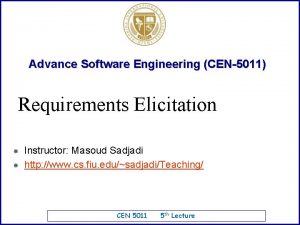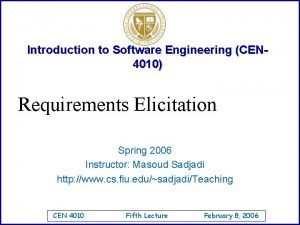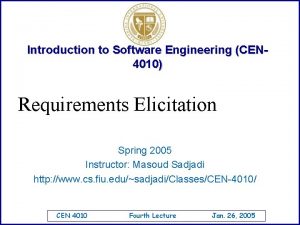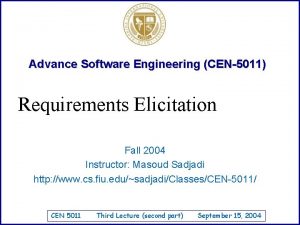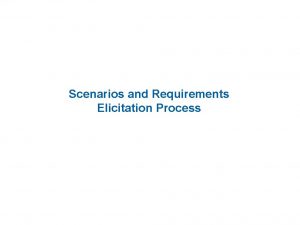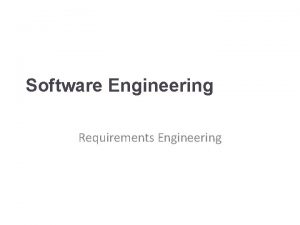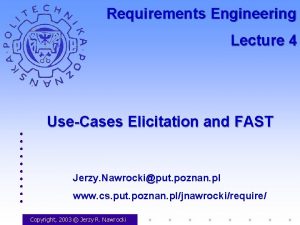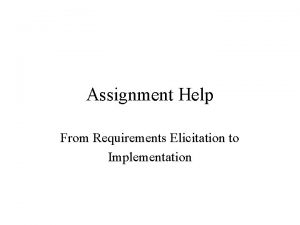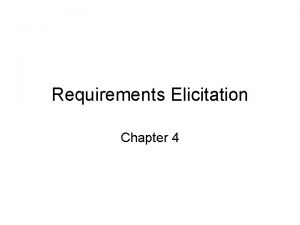SYSC3120 Software Requirements Engineering Software Requirements Elicitation and


![What is a Requirement ? • [Lethbridge] A requirement is a statement about what What is a Requirement ? • [Lethbridge] A requirement is a statement about what](https://slidetodoc.com/presentation_image_h/dd7e4d0a9815e2b807fe940acf3337df/image-3.jpg)















![Quality Example [Lethbridge] Restaurant Advisor System: “This system will allow people to choose a Quality Example [Lethbridge] Restaurant Advisor System: “This system will allow people to choose a](https://slidetodoc.com/presentation_image_h/dd7e4d0a9815e2b807fe940acf3337df/image-19.jpg)

![The importance of organization and priority Encounter game example [Braude, page 200]: 1. Every The importance of organization and priority Encounter game example [Braude, page 200]: 1. Every](https://slidetodoc.com/presentation_image_h/dd7e4d0a9815e2b807fe940acf3337df/image-21.jpg)


















![Use Case [Cockburn] • A use captures a contract between the stakeholders of a Use Case [Cockburn] • A use captures a contract between the stakeholders of a](https://slidetodoc.com/presentation_image_h/dd7e4d0a9815e2b807fe940acf3337df/image-40.jpg)








































































- Slides: 112

SYSC-3120 —Software Requirements Engineering Software Requirements Elicitation and Specification Quotes from disgruntled customers: • They are not listening to what I want for my system. They are giving me the system that they want to build, not the one that I want. • We often don’t know how to say what we want – we know it but don’t know that we do – so it’s their job to listen to us, organize it and say it back to us, better than how we ourselves could say it. SYSC-3120 — Software Requirements Engineering 1

Software Requirements Elicitation and Specification • Fundamentals – – – – Motivation and Goals Requirement Engineering Functional vs. Non-Functional Defining Software System Scope Specifying a Use Case Use case relationships Pitfalls • Requirements Elicitation Process (Requirements Elicitation Based on Use Cases and Scenarios (from Bruegge and Dutoit, 2000)) • Documentation SYSC-3120 — Software Requirements Engineering 2
![What is a Requirement Lethbridge A requirement is a statement about what What is a Requirement ? • [Lethbridge] A requirement is a statement about what](https://slidetodoc.com/presentation_image_h/dd7e4d0a9815e2b807fe940acf3337df/image-3.jpg)
What is a Requirement ? • [Lethbridge] A requirement is a statement about what the proposed system will do that all stakeholders agree must be made true in order for the customer’s problem to be adequately solved. – Statement: brief, concise, fact-based. • Collection of requirements = requirements document – Do: What tasks the system will perform. • Does not describe implementation (the “how”). – All stakeholders: Fundamental purpose is communication vis-à-vis agreements/contracts – Problem: System must be focused on customer’s problem. • [Dutoit] A requirement is a feature that the system must have or a constraint that it must satisfy to be accepted by the customer. SYSC-3120 — Software Requirements Engineering 3

Stating requirements Typical statements… • ATM: the ATM shall allow a customer to access (i. e. , view the balance of) his/her accounts. • Cruise control: the cruise control shall be automatically and immediately disengaged when the driver uses the break pedal. • Air traffic control: the air traffic control software shall run 24 h a day, 7 days a week. • Windows application: the software shall be configurable to any language supported by the operating system. • Anti-collision software: the software shall detect potential colliding aircraft trajectories with at least 5 mn before that can actually happen. SYSC-3120 — Software Requirements Engineering 4

Motivations and Goals (I) • Requirements describes the expected behavior of a system – Functional requirements – Non-functional requirements • Every nontrivial engineering system must be specified, based on user requirements • Requirements need to be explicitly stated and documented for system implementation – e. g. , used for design decisions, verification and validation (see next slide), and a reference point during maintenance • SE is about developing software solutions to problems – Good solutions can only be developed if software engineers understand the problems. SYSC-3120 — Software Requirements Engineering 5

Verification and Validation • Software Verification: IEEE definition (Std 610. 12. 1990) – The process of evaluating a system or component to determine whether the products of a given development phase satisfy the conditions imposed at the start of that phase. – Interpretation: Constructing the system well • The goal is to find as many latent defects as possible before delivery • Checking whether the system adheres to properties termed as verification properties • Software Validation: IEEE definition (Std 610. 12. 1990) – The process of evaluating a system or component during or at the end of the development process to determine whether it satisfies specified requirements. – Interpretation: Constructing the right system • The goal is to gain confidence in the software, shows it meets its specifications • Relationship with other software engineering activities (e. g. , Requirements elicitation, Analysis) SYSC-3120 — Software Requirements Engineering 6

Motivations and Goals (II) • Defects are cheaper when detected earlier • For safety-critical systems, requirements problems are more likely to be safety-related • Failure to understand manage requirements is the biggest single cause of cost and schedule slippage • Requirements documentation treats the software system as a black-box • Separation of concerns: “What” vs. “How” SYSC-3120 — Software Requirements Engineering 7

Surveys • Standish Group surveyed 350 companies, over 8000 projects, in 1994 – 31% cancelled before completed, 9 -16% were delivered within cost and budget – Causes of failed projects: • Incomplete requirements (13%) • Changing requirements and specifications (9%) • Unrealistic expectations (9%) • Lack of user involvement (12%) … • Source: Lutz, 1993, IEEE Int. Symp. On Requirements Engineering – NASA Voyager (87 faults) and Galileo (122 faults) – Safety-related interface faults overwhelmingly caused by communication errors between development teams (93%, 72%) – Functional faults, especially safety-related ones, primarily caused by misunderstanding requirements (62%, 79%) SYSC-3120 — Software Requirements Engineering 8

Software Requirements Elicitation and Specification • Fundamentals – – – – Motivation and Goals Requirement Engineering Functional vs. Non-Functional Defining Software System Scope Specifying a Use Case Use case relationships Pitfalls • Requirements Elicitation Process (Requirements Elicitation Based on Use Cases and Scenarios (from Bruegge and Dutoit, 2000)) • Documentation SYSC-3120 — Software Requirements Engineering 9

Requirements Engineering • Requirements Engineering is the process of defining the requirements for the system under construction • [Dutoit]: Requirements engineering has two main activities: 1. Elicitation : results in requirements specification that the customer understands 2. Analysis: results in analysis model that developer can unambiguously understand Both represent the same information – Specification: communication with customer (informal notation) – Analysis: communication among developers (formal notation) • Traditional terminology: – Requirements specification = = Requirements Definition – Analysis model = = Requirements Specification SYSC-3120 — Software Requirements Engineering 10

Sources of Requirements Stakeholders wants and needs Current organization and systems • • • Best practices Existing documents Requirement templates Domain models … Requirements Current standards, certification • • Standards Legal issues Certification bodies … SYSC-3120 — Software Requirements Engineering 11

Users of the Requirements (Sommerville, 2000) System Customers Specify the requirements and read them to check that they meet their needs. They specify changes to the requirements. Managers Use the requirements document to plan a bid for the system and to plan the system development process. System Engineers Use the requirements to understand what system is to be developed. System Test Engineers Use the requirements to develop validation tests for the system. System Maintenance Engineers SYSC-3120 — Software Requirements Engineering Use the requirements to help understand the system and the relationships between its parts. 12

Products of Requirements Process SYSC-3120 — Software Requirements Engineering 13

Requirements Elicitation - Objectives • Understand the processes, people, and resources involved • Determine the coverage and boundary of the future system (scope) – VERY important decision, huge consequences if wrong • Separate requirements according to level of priority • No implementation decisions (i. e. , No What), unless mandated by customer SYSC-3120 — Software Requirements Engineering 14

Why is Requirements Elicitation hard? • Customers / Users are not always good at describing what they want or need • Software Engineers are not always good at understanding someone else’s concerns • In certain application domains, software engineers and customers have completely different backgrounds and use a different terminology • Volatility: requirements change over time. SYSC-3120 — Software Requirements Engineering 15

Techniques for Requirement Elicitation • Observation – Observe users at work – Obtain subtle information not told by customer (forgotten, didn’t think it was important, didn’t understand implication) • Interviewing – – – Requires skill, preparation, listening Ask specific details: boundaries, exceptions, anticipated changes Ask vision of future Ask alternatives Ask minimally acceptable solution Ask other sources of information • Brainstorming : Moderated meeting with trigger questions • Prototyping : To stimulate reaction by user. SYSC-3120 — Software Requirements Engineering 16

Qualities of Specifications I • Clear, unambiguous, understandable => Need for rigor (and perhaps formality) => But rigor and understandability may be contradictory goals • Realistic (late changes to requirements are expensive) • Correspond to real needs (Valid) • Verifiable (to ease testing), e. g. , use metrics SYSC-3120 — Software Requirements Engineering 17

Qualities of Specifications II • Consistency: lends itself to verifiable, testable, modifiable specifications – the specification is inconsistent if it is self-contradictory => More likely to be inconsistent as complexity grows, and modifications are performed over time • Completeness: – – Respond to all classes of inputs Internally complete, self-contained Complete set of requirements (captures all needs) Includes things the system must not do … SYSC-3120 — Software Requirements Engineering 18
![Quality Example Lethbridge Restaurant Advisor System This system will allow people to choose a Quality Example [Lethbridge] Restaurant Advisor System: “This system will allow people to choose a](https://slidetodoc.com/presentation_image_h/dd7e4d0a9815e2b807fe940acf3337df/image-19.jpg)
Quality Example [Lethbridge] Restaurant Advisor System: “This system will allow people to choose a restaurant in a city. Users enter one or more of the following criteria, and then the system searches its database for suitable restaurants: food type, price range, neighbourhood, size, service type (fast food, cafeteria, buffet, full service), smoking arrangements (none allowed, separately ventilated section, non-separately-ventilated section). The user can also specify a desired day and time period, and the number of people in their party. The system will tap into the reservation database (of participating restaurants) and only display restaurants that have available space. After entering the criteria, the user clicks on “search” and the system displays a list of matching restaurants. For restaurants that participate in the automated reservation system, the user can click on “reserve” next to a selection in order to make a reservation. Point out problems that you find in this “short statement of functional requirements” SYSC-3120 — Software Requirements Engineering 19

Restaurant Advisor System: quality deficiencies • Duplication (ie. saying twice in two different ways) : – System searches for suitable / System displays matching. • Food type, price range, neighbourhood, size are inadequately defined. – Are these taken from a fixed set of values, does a database contain free-form information? Will it be standardized (to make searches easier)? • Ambiguity in “reservation database” and “automated reservation system” – Same thing or not ? • Unclear: It appears that some listed restaurants are not in the reservation system/database. – What does the system do with restaurants that are not participating ? Are they omitted from the list? • Unspecified: Can user select just one option or more than one option for “type of food”, or smoking arrangement. • Incomplete: If user selects “reserve”, there must be some way for the system to record identifying information about the user so restaurant knows who made it. This is omitted. SYSC-3120 — Software Requirements Engineering 20
![The importance of organization and priority Encounter game example Braude page 200 1 Every The importance of organization and priority Encounter game example [Braude, page 200]: 1. Every](https://slidetodoc.com/presentation_image_h/dd7e4d0a9815e2b807fe940acf3337df/image-21.jpg)
The importance of organization and priority Encounter game example [Braude, page 200]: 1. Every character in the Encounter video game shall have a name; 2. Every game character has the same set of qualities, each with a floating point value; 3. Encounter shall take less than a second to compute the results of an engagement; 4. Each area has a specified set of “qualities needed”; 5. When two Encounter game characters are in the same area at the same time, they may either choose or be obliged by the game to engage each other; 6. Every game character shall have an amount of life points; 7. The sum of the value of qualities of a game character relevant to the area in question shall be referred to as the character’s area value. In an engagement the system compares the area values of the characters and computes the result of the engagement. 8. The name of any character shall have no more than 15 letters. SYSC-3120 — Software Requirements Engineering 21

Deficiencies • The organization and order will affect the readers’ understanding • The Encounter game examples are a mix of: – functional (behavioural) requirements (5 and 7) – non-functional performance (3) • Some naturally belong with related ones : – some are about areas(4) – some are about characters (1, 2, 6, 8) – some about engagement (3, 5, 7). • Lack of organization: – makes finding specific requirements hard (especially with big systems) – makes prioritizing hard. SYSC-3120 — Software Requirements Engineering 22

The importance of precision Before: Every area shall have a name of up to 15 characters. After: Every area will have a unique name consisting of 1 to 15 characters. Acceptable characters shall consist of blanks, 0 through 9, a through z, and A through Z only. Before: Every game character has the same set of qualities, each have a floating point value. These are initialized to 100/n where n is the number of qualities. The qualities are attention span, endurance, intelligence, patience and strength. After: Every game character has the same set of qualities. Each quality shall be a nonnegative floating point number with at least one decimal of precision. These are all initialized equally so that the sum of their values is 100. The value of a quality cannot be both greater than 0 and less than 0. 5. For the first release, the default qualities will be concentration, intelligence, patience, stamina and strength. Qualities may be added or removed during configuration, before any characters are created. SYSC-3120 — Software Requirements Engineering 23

Software Requirements Elicitation and Specification • Fundamentals – – – – Motivation and Goals Requirement Engineering Functional vs. Non-Functional Defining Software System Scope Specifying a Use Case Use case relationships Pitfalls • Requirements Elicitation Process (Requirements Elicitation Based on Use Cases and Scenarios (from Bruegge and Dutoit, 2000)) • Documentation SYSC-3120 — Software Requirements Engineering 24

Functional vs. Non-Functional • Functional requirement: – interaction between a system and its environment (e. g. , UML actors) – (independent from its implementation) • Non-Functional requirement: – restriction on the system that limits our choices for constructing a solution – e. g. , memory, platform, real-time constraints. • Non-Functional requirements have as much impact on the system cost and development as functional requirements. SYSC-3120 — Software Requirements Engineering 25

Types of NF Requirements • Usability: the ease with which a user can learn to operate, prepare inputs for, and interpret outputs of a system. – Relates to the user interface—number of nested levels in menus, color schemes …, online help, level of documentation … • Dependability: the property of a system such that reliance can justifiably be placed on the service it delivers. Includes reliability, robustness, and safety. • Reliability: the ability of a system to perform its required functions under stated conditions for a specified period of time. – Includes acceptable mean time to failure, the ability to detect specified faults or withstand specified security attacks • Robustness: the degree to which a system can function correctly in the presence of invalid inputs or stressful environment conditions. • Safety: A measure of the absence of catastrophic consequences to the environment. SYSC-3120 — Software Requirements Engineering 26

Types of NF Requirements (cont. ) • Performance: Quantifiable attributes of the system such as response time, throughput, availability, accuracy. • Response time: how quickly the system reacts to a user input. • Throughput: how much work the system can accomplish within a specified amount of time. • Availability: the degree to which a system is operational and accessible when required for use. – E. g. , an availability of 0. 998 means that in every 1000 time units, the system is likely to be available for 998 units. • Accuracy: a quantitative measure of the magnitude of error. SYSC-3120 — Software Requirements Engineering 27

Types of NF Requirements (cont. ) • Supportability: Requirements concerned with the ease of changes to the system after deployment. Includes adaptability, maintainability. • Adaptability: the ability to change the system to deal with additional application domain concepts. • Maintainability: the ability to change the system to deal with new technology or to fix defects. • In practice, NF requirements have to be prioritized by importance. Some of them need to be met for the system to operate correctly. SYSC-3120 — Software Requirements Engineering 28

Sommerville’s Classification Non-functional requirements Product requirements Usability requirements Efficiency requirements Performance requirements Reliability requirements Space requirements Organizational requirements Portability requirements Delivery requirements SYSC-3120 — Software Requirements Engineering External requirements Interoperability requirements Implementation requirements Ethical requirements Standards requirements Legislative requirements Privacy requirements Safety requirements 29

Examples • The product should identify an aircraft within 0. 25 seconds • The product should be used with poor lighting conditions and the users will wear gloves • The product should be easy to use with only one hand • The system shall not disclose any personal information about customers • The product should be readily portable to the Linux operating system. SYSC-3120 — Software Requirements Engineering 30

What is usually not in the Requirements? • • • System structure, implementation technology Development methodology Development environment Implementation language Reusability It is desirable that none of these are constrained by the client • But in certain application domains, like airborne systems, military systems, there are (international) standards to follow. SYSC-3120 — Software Requirements Engineering 31

Realistically • Many requirements can only be clearly identified after some experience with the system => incrementality • Some amount of imprecision (“common knowledge”) is accepted – e. g. , what is a saving bank account in a given banking environment, • Responsibility of users and software engineers to determine what is acceptable. SYSC-3120 — Software Requirements Engineering 32

NF Requirements Metrics examples Property Metric • Speed • • • • • Size • Ease of use • Reliability • Robustness • Portability Process transactions per second User/event response time Screen refresh time Notice how each metric is a K Bytes quantifiable amount – a number Number of RAM chips to be verified! Even portability Training time Number of help frames Mean time between failure (MTBF) Probability of unavailability Rate of failure occurrence Availability Time to restart after failure Percentage of events causing failure Probability of data corruption on failure Percentage of target dependent statements Number of target systems SYSC-3120 — Software Requirements Engineering 33

Software Requirements Elicitation and Specifications • Fundamentals – – – – Motivation and Goals Requirement Engineering Functional vs. Non-Functional Defining Software System Scope Specifying a Use Case Use case relationships Pitfalls • Requirements Elicitation Process (Requirements Elicitation Based on Use Cases and Scenarios (from Bruegge and Dutoit, 2000)) • Documentation SYSC-3120 — Software Requirements Engineering 34

Defining the Software System Scope • VERY important decision, huge consequences if wrong • System Boundary: define activities and data IN the system • Fundamental questions: – What/who triggers the behaviour expected from the software? – Should we implement the requirements or is the requested functionality a responsibility of another system or a human? • We need to know the context in which a system operates • External entities: – other systems, organizations, people, machines, device (sensor, actuator), etc. that expect services/data from us or provide services to us • Input/Output data flows from/to external entities SYSC-3120 — Software Requirements Engineering 35

Scope Example • Web-based store: The system allows the purchase of items over the web. When a purchase it made, inventory is checked and updated and the total cost is computed. Because it is web-based, foreign purchases may be made, requiring the cost to be computed in the foreign currency using that day’s currency exchange rate. • Two databases can be envisioned: – Inventory/price database: For each item, number available and price – Google’s currency exchange database • Question: Define the scope of the system. In particular, are the databases inside or outside the system ? Answer: – Google’s currency exchange database is outside the system (i. e. , an actor) – Inventory/price database is internal • however, the DBMS used to implement it is not part of the system, • only the schema definition and DB queries are part of the system. SYSC-3120 — Software Requirements Engineering 36

Software System Scope in UML—Use Case Diagram Communication between the actor and the system Use case Staff Contact Actor SYSC-3120 — Software Requirements Engineering System or subsystem boundary 37

Defining Software System Scope • Defines what is IN the software system – Defines what is OUT of the software system • Defines what is the responsibility of the software • Defines what the engineers have to build • Can be a binding (legal) description of the software system SYSC-3120 — Software Requirements Engineering 38

Software Requirements Elicitation and Specifications • Fundamentals – – – – Motivation and Goals Requirement Engineering Functional vs. Non-Functional Defining Software System Scope Specifying a Use Case Use case relationships Pitfalls • Requirements Elicitation Process (Requirements Elicitation Based on Use Cases and Scenarios (from Bruegge and Dutoit, 2000)) • Documentation SYSC-3120 — Software Requirements Engineering 39
![Use Case Cockburn A use captures a contract between the stakeholders of a Use Case [Cockburn] • A use captures a contract between the stakeholders of a](https://slidetodoc.com/presentation_image_h/dd7e4d0a9815e2b807fe940acf3337df/image-40.jpg)
Use Case [Cockburn] • A use captures a contract between the stakeholders of a system about the system behaviour. – What the actor expects from, sends to the system – What the system ensures to, expects form the actor • A use case describes the system’s behaviour under various conditions as the system responds to a request from one of the stakeholders, called the primary actor. – The primary actor has a goal with the software system • The system responds, protecting the interests of all the stakeholders (not all stakeholders are actors) • Different behaviours (i. e. , scenarios) can unfold – Including descriptions of what may go wrong SYSC-3120 — Software Requirements Engineering 40

Use Cases and Actors • A primary actor has a goal with the software system • The system has a responsibility: to achieve the goal of the primary actor • The system formulates sub-goals to carry out its responsibility – Some sub-goals can become other use cases (carried out internally) – Some sub-goals can be achieved with the help of another (secondary) actor (carried our externally) • Recall the fundamental question: Should we implement the requirements or is the requested functionality a responsibility of another system or a human? SYSC-3120 — Software Requirements Engineering 41

Use Case Scope/Extent • How much does a use case describe? – How many things are done in a use case – How many scenarios? – How many steps? • Answer: what is the actor’s goal? [Cockburn] • A use case usually passes the one person, one sitting test – Can the primary actor go away happy after the use case finishes? – Coffee break test: “after I get done with this, I can take a coffee break” – 2 -20 mn long to follow the steps of a use case. SYSC-3120 — Software Requirements Engineering 42

Use Case Scope/Extent (cont. ) • Some (potential) use cases do not pass this test, and should not count as user goals: – Use Case "Complete an on-line auction purchase“ • On-line auctions take several days, so fail the single-sitting test. • This long “goal” should be split: e. g. , making the auction publicly available, making a bid, changing a bid, selecting the “winner” – Use Case "Log on“ • Logging on 42 times in a row does not (usually) satisfy the person’s job responsibilities or purpose in using the system. • Instead Login in is not a system behaviour that is that much interesting to stakeholders (from a functional point of view). However, this is a behaviour the system will need to exhibit, and this will therefore be a use case. – Use Case "Register a new customer" • Registering 42 new customers has some significance to a sales agent. – Use Case "Buy a book" • A book purchase can be completed in a single sitting. SYSC-3120 — Software Requirements Engineering 43

Specifying a Use Case (template) Use case are described by following template descriptions, which typically include the following sections (many different templates exist): • • • Use Case Name Brief Description Precondition Primary Actor Secondary Actors Dependencies to other use cases Basic Flow Alternative Flows: Specific, Bounded, Global Alternative Flows Special requirements Technology and data variations Open issues SYSC-3120 — Software Requirements Engineering 44

Specifying a Use Case (cont. ) Use case name: • Should be a verb phrase denoting what the actor is trying to accomplish (goal) • Should reflect the perspective of the actor – E. g. , “perform withdrawal” instead of “record withdrawal” Precondition • States what must always be true before any scenario of the use case begins. Primary Actor – The principal actor that initiates the use case. Secondary Actors – The secondary actors that the system relies on to accomplish some of the sub-goals. Dependencies to other use cases (see later) – <<include>> and <<exclude>> relationships between use cases. – Generalization relationship between use cases. SYSC-3120 — Software Requirements Engineering 45

Specifying a Use Case (cont. ) Basic Flow – Describes a typical success path that satisfies the interests of the stakeholders. It often does not include any conditions or branching. – A step can be one of the following interactions: 1. Primary actor system: the primary actor sends a request and data to the system. 2. System system: the system validates a request and data. 3. System system: the system alters its internal state (e. g. , recording or modifying something) 4. System secondary actor: the system sends requests to a secondary actor. – The first step (outside this classification) often indicates the trigger event that starts the scenario. – All steps are numbered sequentially: 1. <description of first step> 2. <second step> … – Use active voice only – Postcondition: what should be true after the basic flow has executed. SYSC-3120 — Software Requirements Engineering 46

Specifying a Use Case (cont. ) Alternative flows – Describe all the other scenarios or branches, both success and failure. An alternative flow always depends on a condition occurring in a specific step in a flow of reference, referred to as reference flow step (RFS), and that reference flow is either the basic flow or an alternative flow itself. – All action steps are numbered sequentially. – Each alternative flow must have a postcondition. Three types of alternative flows: – Specific alternative flow: an alternative flow that refers to a specific step in the reference flow (either a main flow or another alternative flow). – Bounded alternative flow: an alternative flow that refers to more than one step in the reference flow–consecutive steps or not. – Global alternative flow: an alternative flow that refers to any step in the reference flow. SYSC-3120 — Software Requirements Engineering 47

Specifying a Use Case (cont. ) Special Requirements – If a non-functional requirement, quality attribute, or constraint relates specifically to the use case, list it here. Technology and Data Variation – Foreseeable technology changes are listed • E. g. , providing credit account input using a card reader and the keyboard – Foreseeable input type variations • E. g. , metric vs. imperial – The list can refer to steps in the basic or alternate flows. Open issues – Lists what remains to be clarified with stakeholders • E. g. , terminology. SYSC-3120 — Software Requirements Engineering 48

Specifying a Use Case (cont. )—possible layout SYSC-3120 — Software Requirements Engineering 49

Specifying a Use Case (cont. ) • See example of the report emergency use case (pdf file). • See example of the withdraw funds use case (pdf file). SYSC-3120 — Software Requirements Engineering 50

Specifying a Use Case (restricting the use of English) • The subject of a sentence should be “the system” or an actor. – The card has been ejected. (passive voice) – The system ejects the ATM card. (active voice) • Describe the flow of events sequentially (a use case describes what should happen). • Actor-to-actor interactions are not allowed (these interactions are not supported by the software you specify, are they? ). – The customer gives the teller the ATM card. – The customer inserts the ATM card into the card reader. • Describe one action per sentence. • Use present tense only. – The system ejected the card. – The system ejects the card. • Use active voice rather than passive voice. – The card is ejected. – The system ejects the card. SYSC-3120 — Software Requirements Engineering 51

Specifying a Use Case (cont. ) • Clearly describe the interaction between the system and actors without omitting its sender and receiver. – Customer enters PIN. – ATM customer enters PIN number to the system. • Use declarative sentence only. “Is the system idle? ” is a nondeclarative sentence. – Ejects the card. – The system ejects the card. • Use words in a consistent way. Keep one term to describe one thing. – Customer inserts the ATM card… – ATM customer inserts the ATM card… • Don’t use modal verbs (e. g. , might) nor adverbs (e. g. , very) – The system might eject the card. – The system ejects the card. SYSC-3120 — Software Requirements Engineering The system likely ejects the The system ejects the card 52

Specifying a Use Case (cont. ) • Use simple sentences only. A simple sentence must contain only one subject and one predicate. System displays customer accounts and prompts customer for transaction type… 1. The system displays ATM customer accounts. 2. The system prompts ATM customer for … • Don’t use negative adverb and adjective (e. g. , hardly, never), but it is allowed to use not or no. – The PIN number has never been validated. – The PIN number has not been validated • Don’t use pronouns (e. g. he, this, it) – …it reads the card number. – …the system reads the card number. • Don’t use participle phrases as adverbial modifier. – ATM is idle, displaying a Welcome message. – The system is idle. The system is displaying a Welcome message. SYSC-3120 — Software Requirements Engineering 53

Specifying a Use Case (cont. ) • INCLUDE USE CASE = including another use cases. – Grammar • INCLUDE USE CASE <included use case name> – Example: • Include Validate. PIN use case. • INCLUDE USE CASE Validate. PIN • EXTENDED BY USE CASE = extension by another use case. – Grammar • EXTENDED BY USE CASE <extending use case> – Example: • Use case Create. Incident extends the current use case. • EXTENDED BY USE CASE Create. Incident SYSC-3120 — Software Requirements Engineering 54

Specifying a Use Case (cont. ) • RFS = reference flow step (number(s)) – Grammar • RFS <reference flow step #> (specific alternative flow) • RFS <reference flow step numbers> (bounded alternative flow) • Not required for global alternative flow. – Explanation • One specific or bounded alternative flow must correspond to exactly one or more than one reference flow steps. – Example: • RFS Basic Flow 5 … • RFS Basic Flow 5 -7, 10, 14 … • IF, THEN, ELSEIF, and ENDIF = conditional logic. – Grammar • IF <condition> THEN <steps> ENDIF • IF <condition> THEN <steps> ELSEIF <condition> THEN <steps> ENDIF – Example: IF the system recognizes the ATM card, THEN the system reads the ATM card number, ENDIF. SYSC-3120 — Software Requirements Engineering 55

Specifying a Use Case (cont. ) • MEANWHILE = concurrency. – Grammar • <action> MEANWHILE <action> – Example: • the system cancels the transaction and ejects the card. • the system cancels the transaction MEANWHILE the system ejects the card. • VALIDATES THAT = a condition is evaluated. – Grammar • VALIDATES THAT <condition> – Explanation • a condition is evaluated and must be true to proceed to the next step. • the alternative case (the condition does not hold) must be described in a corresponding alternative flow (BFS). – Example: • the system checks whether the user-entered PIN… • the system VALIDATES THAT the user-entered PIN… SYSC-3120 — Software Requirements Engineering 56

Specifying a Use Case (cont. ) • DO … UNTIL = iteration. – Grammar • DO <steps> UNTIL <condition > – Explanation • Following keyword DO is a sequence of steps. Following keyword UNTIL is a loop ending condition. – Example: 1. DO 2. action 1 3. action 2 4. UNTIL condition • ABORT = an exceptionally exit action. – Grammar • ABORT – Explanation • Used in alternative flows, iterative, and conditional logic sentences. It means the ending of a use case. • An alternative flow ends either with ABORT or RESUME STEP. SYSC-3120 — Software Requirements Engineering 57

Specifying a Use Case (cont. ) • RESUME STEP = an alternative flow goes back to its corresponding basic flow. – Grammar • RESUME STEP <basic flow step #> – Explanation • Used in alternative flows. SYSC-3120 — Software Requirements Engineering 58

Specifying a Use Case (summary) • Template + Restrictions = – Facilitates communication between stakeholders (fewer ambiguities) – Facilitates subsequent phases in development • Requirements are used in many phases and ought to be correct and understandable – Facilitates automation! • • • Checking consistency Producing documentation Producing glossary of terms (domain) Generating analysis document (first draft) … SYSC-3120 — Software Requirements Engineering 59

Software Requirements Elicitation and Specifications • Fundamentals – – – – Motivation and Goals Requirement Engineering Functional vs. Non-Functional Defining Software System Scope Specifying a Use Case Use case relationships Pitfalls • Requirements Elicitation Process (Requirements Elicitation Based on Use Cases and Scenarios (from Bruegge and Dutoit, 2000)) • Documentation SYSC-3120 — Software Requirements Engineering 60

<<include>> • Used to: – – Decompose larger/longer use case Share functionalities The included use case is always triggered when the base use case is. The base use case delegates (sub)goals to the included use case • Example: – The use case View. Map describes behaviour that can be used by the use case Open. Incident and the use case Allocate. Resources Base Use Case Open. Incident <<include>> View. Map Allocate. Resources SYSC-3120 — Software Requirements Engineering <<include>> 61

<<extend>> • Problem: – The functionality in the original problem statement needs to be extended to account for exceptional flow of events. • Solution: – An extend association from (direction of the arrow head) a use case A to a use case B indicates that use case A is an extension of use case B. – This specifies that use case A is triggered when use case B executes only under some condition Report. Emergency <<extend>> Connection. Down Base Use Case SYSC-3120 — Software Requirements Engineering 62

Use case generalization • A (base) use can be specialized by another use case • No much use! – “Use case experts have been successfully doing use case work without this optional relationship […] and there is not yet agreement by practitioners on the best-practice guidelines of how to get value from this idea. ” [Larman] SYSC-3120 — Software Requirements Engineering 63

Example I <<extend>> Place. Order Place. Rush. Order <<include>> Validate. User Track. Order <<include>> SYSC-3120 — Software Requirements Engineering 64

Example II SYSC-3120 — Software Requirements Engineering 65

Software Requirements Elicitation and Specifications • Fundamentals – – – – Motivation and Goals Requirement Engineering Functional vs. Non-Functional Defining Software System Scope Specifying a Use Case Use case relationships Pitfalls • Requirements Elicitation Process (Requirements Elicitation Based on Use Cases and Scenarios (from Bruegge and Dutoit, 2000)) • Documentation SYSC-3120 — Software Requirements Engineering 66

Common mistake : Identifying wrong actor • Consider a purchase system for any kind of store (Sears, Leons, AMC Theatre, Mac. Donald’s). Customers give the cashier their order. The cashier enters the selection ( the item’s bar code, the selected movie, the number of Big Macs) and the system calculates the total. Purchase System Customer Nowhere in the description above the customer is said to interact with the system Cashier • The customer gives payment (debit/credit card) and the transaction is complete. Customer Purchase System SYSC-3120 — Software Requirements Engineering Cashier 67

<<Include>>: Functional Decomposition • Problem: – A function in the original problem statement is too complex to be solvable immediately • Solution: – Describe the function as the aggregation of a set of simpler functions. The associated use case is decomposed into smaller use cases Manage. Incident <<include>> Create. Incident Handle. Incident Close. Incident • However: remember the “one person, one sitting” test? Create. Incident Handle. Incident Close. Incident SYSC-3120 — Software Requirements Engineering 68

Discussion : <<include>> as Functional Composition A typical login situation do. X do. Y login <<include>> do. Z do. X do. Y do. Z Neither is right or wrong. Instead, they mean different things. SYSC-3120 — Software Requirements Engineering 69

In What Order Do Use Cases Execute? • For each actor, we identify what that actor wants to do with the system. – Each of these things that the actor wants to do with the system become a Use Case. – E. g. , an actor wants to perform tasks A, B, C, and D with the system. • This leads to 4 different use cases, all triggered by the actor. • But perhaps, A is always being triggered before the other three? • This cannot be modeled by a use case diagram! • Solution: UML Activity diagram (mentioned in Bruegge&Dutoit) – Activities are use cases. – Swimlanes can be actors or domain objects (data manipulated in use cases) – Activity diagram notation: conditions, loops, fork/join … SYSC-3120 — Software Requirements Engineering 70

Use Case Order: The Library Example SYSC-3120 — Software Requirements Engineering 71

Software Requirements Elicitation and Specifications • Fundamentals • Requirements Elicitation Process – – – – (Requirements Elicitation Based on Use Cases and Scenarios (from Bruegge and Dutoit, 2000)) Identifying actors Identifying scenarios Identifying use cases Identifying non-functional requirements Refining use cases Relationships between use cases Summary • Documentation SYSC-3120 — Software Requirements Engineering 72

Use Case Model • Define system functional requirements in terms of Actors and Use Cases – Each use case defined in terms of sequences of interactions between Actor and System • Structured narrative description, sequence diagram – Basic sequences • Most common sequences – Alternative sequences • Error conditions • Use case associations (include, extend) SYSC-3120 — Software Requirements Engineering 73

Requirements Elicitation Activities 1. Identify actors • Identify the different types of users of the future system 2. Identify scenarios • Identify scenarios for typical functionalities 3. Identify use cases • Abstract scenarios into use cases 4. Identify nonfunctional requirements • Identify aspects visible to the user but not directly related to functionalities 5. Refine use cases • Is the system specification complete (e. g. , exceptional conditions) 6. Identify relationships among use cases • Consolidate the use case model by eliminating redundancies SYSC-3120 — Software Requirements Engineering 74

1. Identify Actors • • • Can be human or external system, device Define system boundaries Find all stakeholders May correspond to roles in an organization Need to differentiate roles only when they access different functionality • Classes of functionality SYSC-3120 — Software Requirements Engineering 75

Questions to Ask • Which user groups are supported by the system to perform their work? • Which user groups execute the system’s main functions? • Which user groups perform secondary functions, such as maintenance and administration? • Will the system interact with any external hardware or software system? SYSC-3120 — Software Requirements Engineering 76

FRIEND: Accident Management System • It is a distributed information system for managing accidents. It allows dispatchers and authorities to communicate and allocate resources to an emergency. Field. Officer FRIEND Dispatcher • Problem: Long list of potential actors – Firefighters, police officers, dispatchers, investigators, … • We need to consolidate the list into a small number of actors who are different from the point of view of the system usage – A firefighter and a field police officer share the same interface, both involved with a single incident on the field – Dispatcher manages multiple concurrent incidents and requires access to more information SYSC-3120 — Software Requirements Engineering 77

2. Identify scenarios Bridging the gap between the user and the developer • Scenarios: Example of the use of the system in terms of a series of interactions between an actor and the system • Use cases: Abstraction that describes a class of scenarios (e. g. , end user functionalities) SYSC-3120 — Software Requirements Engineering 78

Scenarios • “A narrative description of what people do and experience as they try to make use of computer systems and applications” [M. Carrol, Scenario-based Design, Wiley, 1995] • A concrete, focused, informal description of a single feature of the system used by a single actor. • Readily understandable by clients and users • Developers and users write and refine a series of scenarios in order to gain a shared understanding of what the system should be. – Iterative process. SYSC-3120 — Software Requirements Engineering 79

Heuristics for finding Scenarios • Ask yourself or the client the following questions: – What are the primary tasks that the system needs to perform? – What data will the actor create, store, change, remove or add in the system? – What external changes / events does the system need to know about? – What changes or events will the actor of the system need to be informed about? • Insist on task observation if a system already exists – Ask to speak to the end user, not just to the software contractor – Expect resistance and try to overcome it • Sources of information: – User manuals of previous systems, procedure manuals, company standards, user and client interviews SYSC-3120 — Software Requirements Engineering 80

FRIEND Scenario: Warehouse on Fire • Scenario: – A fire is detected in a warehouse; two field officers arrive at the scene and request resources • Source of information: – Observation or discussions with actual, future users of the system about how they would use the system (or are using the current system) in certain circumstances • Details: – Bob, driving down main street in his patrol car notices smoke coming out of a warehouse. His partner, Alice, reports the emergency from her car. – Alice enters the address of the building, a brief description of its location (i. e. , north west corner), and an emergency level. In addition to a fire unit, she requests several paramedic units on the scene given that the area appears to be relatively busy. She confirms her input and waits for an acknowledgment. – John, the Dispatcher, is alerted to the emergency by a beep of his workstation. He reviews the information submitted by Alice and acknowledges the report. He allocates a fire unit and two paramedic units to the Incident site and sends their estimated arrival time (ETA) to Alice. – Alice received the acknowledgment and the ETA. SYSC-3120 — Software Requirements Engineering 81

Observations about Warehouse on Fire Scenario • Concrete scenario – Describes a single instance of reporting a fire incident. – Does not describe all possible situations in which a fire can be reported. • Participating actors – Bob, Alice: Field officer (Primary Actor) – and John, Dispatcher (Other stakeholder) SYSC-3120 — Software Requirements Engineering 82

FRIEND: Other Scenarios • Fender. Bender: – A car accident without casualties occurs on the highway. – Police officers document the incident and manage traffic while the damaged vehicles are towed away. • Earthquake: – An unprecedented earthquake seriously damages buildings and roads, spanning multiple accidents and triggering the activation of the statewide emergency operations plan. Objective of defining scenarios: – shared understanding of the user work processes that need to be supported – understanding of the scope of the system. Next step: Scenarios have now to be formalized into use cases SYSC-3120 — Software Requirements Engineering 83

3. Identify Use Cases • A scenario is an instance (or a realization) of a use case • A use case specifies all possible scenarios for a given piece of functionality – Find hints for a use case in the scenario descriptions, e. g. , “Report Emergency “ in the first paragraph of the scenario is a candidate for a use case – Report Emergency accounts for all possible scenarios, i. e. , Warehouse on fire, Fender. Bender, Earthquake etc. • A use case is always initiated by an actor but may interact with other actors as well • A use case is a complete flow of events through the system SYSC-3120 — Software Requirements Engineering 84

Steps in Formulating a Use Case (I) • First name the use case – Use case name: Report. Emergency • Then find the actors – Generalize the concrete names (“Bob”) to participating actors (“Field officer”) – Participating Actors: Report. Emergency • Field Officer (Initiator) • Dispatcher • Then concentrate on the flow of events • Pre and post conditions SYSC-3120 — Software Requirements Engineering 85

Formulate the Flow of Events 1. The Field. Officer activates the “Report Emergency” function on her terminal. 2. FRIEND responds by presenting a form to the officer. 3. The Field. Officer fills the form, by selecting the emergency level, type, location, and brief description of the situation. The Field. Officer also describes possible responses to the emergency situation. Once the form is completed, the Field. Officer submits the form 4. FRIEND receives the form and notifies the Dispatcher. 5. The Dispatcher reviews the submitted information and creates an incident in the database by invoking the Open. Incident use case. The Dispatcher acknowledges the emergency report and selects a response. SYSC-3120 — Software Requirements Engineering 86

Entry and Exit Conditions • Precondition: – The Field. Officer is logged into FRIEND • Post-condition: – The Field. Officer has received an acknowledgement and the selected response from the Dispatcher, OR – The Field. Officer has received an explanation indicating why the transaction could not be processed SYSC-3120 — Software Requirements Engineering 87

Steps in formulating a use case (II) • Write down the exceptions: – The Field. Officer is notified immediately if the connection between her terminal and the central is lost. – The Dispatcher is notified immediately if the connection between any logged in Field. Officer and the central is lost. • Identify and write down any quality (NF) requirement: – The Field. Officer’s report is acknowledged within 30 seconds. – The selected response arrives no later than 2 minutes after it is sent by the Dispatcher. SYSC-3120 — Software Requirements Engineering 88

Writing Guidelines (I) • Use cases should be named with verb phrases. The name of the use case should indicate what the user is trying to accomplish – e. g. , Report. Emergency, Open. Incident. • Actors should be named with noun phrases – e. g. , Field. Officer, Dispatcher, Victim. • The boundary of the system should be clear: Steps accomplished by the actor and steps accomplished by the system should be distinguished. • Use case steps in the flow of events should be phrased in the active voice. This makes it explicit who accomplished the step. SYSC-3120 — Software Requirements Engineering 89

Writing Guidelines (II) • The causal relationship between successive steps should be clear. • A use case should describe a complete user transaction – e. g. , the Report. Emergency use case describes all the steps between initiating the emergency reporting and receiving an acknowledgement). • Exceptions and alternative flows should be described separately. • A use case should not describe the user interface of the system. This takes away the focus from the actual steps accomplished by the user and is better addressed with visual mockups – e. g. , the Report. Emergency only refers to the “Report Emergency” function, not the menu, the button, nor the actual command that corresponds to this function. • A use case should not exceed two or three pages in length. Otherwise, use include and extends relationships to decompose it in smaller use cases. SYSC-3120 — Software Requirements Engineering 90

4. Identify Non-Functional (NF) Requirements • User-visible aspects of the system that are not directly related to the functional behavior of the system • It is important to be systematic when eliciting quality requirements. • Use template questions. – See examples on next slides. – Standards (IEEE, Do. D) also help with this. • Template questions for: – Usability – Performance – Reliability SYSC-3120 — Software Requirements Engineering 91

Template Questions for NF Requirements Usability • What is the level of expertise of the user? • What are the user interface standards familiar to the user? • What documentation should be provided to the user? SYSC-3120 — Software Requirements Engineering 92

Template Questions for NF Requirements (II) Performance • How responsive should the system be? • Are there user tasks that are time critical? • How many concurrent users should it support? • How large is a typical data store for comparable systems? • What is the worse latency that is acceptable for users? SYSC-3120 — Software Requirements Engineering 93

Template Questions for NF Requirements (III) Reliability • How reliable, available, robust should the system be? • Is restarting the system acceptable in the event of a failure? • How much data can the system loose? • How should the system handle exceptions? • Are there safety requirements on the system? • Are there security requirements on the system? SYSC-3120 — Software Requirements Engineering 94

5. Refining Use Cases • Precision, correctness and completeness and consistency • Expect Use Cases to change a lot and have many iterations • Scenarios and user interface mock-ups can be used to help exploration and validation • Links to other use cases (Allocate. Resources in FRIEND) • Report. Emergency: – Include details about the type of incident known to FRIEND – Detail how the Dispatcher acknowledges the report of the Field. Officer SYSC-3120 — Software Requirements Engineering 95

Refinement Example (I) 1. The Field. Officer activates the “Report Emergency” function on her terminal. 2. FRIEND responds by presenting a form to the Field. Officer. The form includes an emergency type menu (general emergency, fire, transportation), a location, incident description, resource request, and hazardous material fields. 3. The Field. Officer fills the form specifying minimally the emergency type and description fields. The Field. Officer may also describe possible responses to the emergency situation and request specific resources. Once the form is completed, the Field. Officer submits the form. 4. FRIEND receives the form and notifies the Dispatcher. SYSC-3120 — Software Requirements Engineering 96

Refinement Example (II) 5. The Dispatcher reviews the submitted information and creates an incident in the database by invoking the Open. Incident use case. All the information contained in the Field. Officer’s form is automatically included in the incident. The Dispatcher selects a response by allocating resources to the incident (with the Allocate. Resources use case) and acknowledges the emergency report by sending a short message to the Field. Officer. 6. The Field. Officer receives the acknowledgment and the selected response. SYSC-3120 — Software Requirements Engineering 97

Use Case Diagram for FRIEND SYSC-3120 — Software Requirements Engineering 98

6. Identify relationships among use cases • Even simple systems have a lot of use cases • Use case dependency = relationship between use cases • Goal: Reduce complexity, Increase understandability, maximize reuse of use cases • Important relationships: – Extend • A use case extends another use case (separate exceptional and common flows of events) – Include • A use case uses another use case (“functional decomposition”) – Generalization • “Use case experts have been successfully doing use case work without this optional relationship […] and there is not yet agreement by practitioners on the best-practice guidelines of how to get value from this idea. ” [Larman] SYSC-3120 — Software Requirements Engineering 99

Connection. Down The Connection. Down use case extends Report. Emergency when the connection between the Field. Officer and the Dispatcher is lost. 1. The Field. Officer and the Dispatcher are notified that the connection is broken. They are advised of the possible reasons why such an event occur (e. g. , going through a tunnel). 2. The situation is logged by the system and recovered when the connection is reestablished. 3. The Field. Officer and the Dispatcher enter in contact though other means and the Dispatcher initiates Report. Emergency from the Dispatcher station. SYSC-3120 — Software Requirements Engineering 100

Summary • Scenarios and Use Cases is one way to document and formalize requirements in a form which is understandable by users and clients • Scenarios are the basis to derive Use Cases • Use Cases relationships can be used to simplify the use case model: extend, include • They are modeled as stereotypes of UML dependencies • Other relationships could be imagined: sequential dependencies … SYSC-3120 — Software Requirements Engineering 101

Tips from Authors • Lethbridge: – A use case should describe the user’s interaction with the system, not the computations the system performs. – A use case should be written to be as independent as possible from any particular user interface design. • No: Push the Open button • Yes: Choose the Open command. – In general, a use-case should cover the full sequence of steps from the beginning of a task until the end. • Fowler: Although use cases have been around for a while, there’s been little standardization on their use. The UML is silent on the important contents of a use case and has standardized only the much less important diagrams. As a result, you can find a divergent range of opinions on use cases. • Breugge & Dutoit : Do not overstructure the use case model. A few longer use cases (eg. 2 pages long) are easier to understand review than many short ones (eg. ten lines long) SYSC-3120 — Software Requirements Engineering 102

Advantages of using Use-Cases • Helps define the scope of the system ( what it does and does not do) • Can be used as part of the development plan – # use cases is an indicator of project size – progress can be measured by % use cases completed • Form the basis of definition of test cases • Can be used to structure user manuals SYSC-3120 — Software Requirements Engineering 103

Disadvantages of Use-Cases 1) Use cases themselves must be validated 2) Some aspects of functional requirements may not be covered by use case analysis, only those triggered by an actor. – – Automatic cleaning of a database to remove outdated information may not appear in user’s use-case Solution: Have different packages of use-case, for different stakeholders – user vs. maintainer. 3) When software requirements are derived from use-cases, the software tends simply to mirror the way users worked BEFORE the software was developed. Innovative solution may not be considered. SYSC-3120 — Software Requirements Engineering 104

Software Requirements Elicitation and Specifications • Fundamentals • Requirements Elicitation Process (Requirements Elicitation Based on Use Cases and Scenarios (from Bruegge and Dutoit, 2000)) • Documentation SYSC-3120 — Software Requirements Engineering 105

Requirements Definition document • • Defines system to be built from the customer’s perspective Customer needs to understand the document Basis of contract between customer and system developer Requirements ought to be complete and consistent!!! SYSC-3120 — Software Requirements Engineering 106

Software requirements document • • Cover page Introduction Functional requirements specification Nonfunctional requirements (e. g. standards to be met, platform, memory requirements) • Glossary SYSC-3120 — Software Requirements Engineering 107

Software requirements document cover page • • • Name of the project/product Date Version number Author(s) Responsibilities of every author Key changes since last version SYSC-3120 — Software Requirements Engineering 108

Format and Style • Modifiability – Well-structured, indexed, cross-referenced – Little and explicit redundancy • Traceability – Backwards, e. g. , stakeholder, document – Forwards, e. g. , to design, test plan • Useful annotations: levels of necessity, stability SYSC-3120 — Software Requirements Engineering 109

Review - questions • • • Important interfaces described? Major functions within scope? Design constraints realistic? Technological risk considered? Clear validation criteria stated? Do inconsistencies, omissions, redundancy exist? SYSC-3120 — Software Requirements Engineering 110

Review - guidelines • Lookout for persuasive connectors (certainly, therefore, obviously, …. ) • Watch for vague terms (some, often, usually, …. ) • Lists complete (no etc. , such as, …) • Check the use of terms: always the same meaning in document? • Beware ambiguity and vague statements (e. g. , undefined terminology) SYSC-3120 — Software Requirements Engineering 111

Standards • IEEE-STD-830 -1993. – IEEE Recommended Practice for Software Requirements Specifications • MIL-STD-498. – Military Standard for Software Development and Documentation. • DO-178 B. – Promotes traceability between high-level requirements down to code statements (airborne systems) Similar standards exist for public transportation (train), power plants … SYSC-3120 — Software Requirements Engineering 112
 Requirements elicitation lifecycle
Requirements elicitation lifecycle Questionnaire elicitation techniques
Questionnaire elicitation techniques What is elicitation
What is elicitation Teknik requirement elicitation
Teknik requirement elicitation Elicitation techniques
Elicitation techniques Prototyping elicitation technique
Prototyping elicitation technique 7 tasks of requirement engineering
7 tasks of requirement engineering Contoh requirement
Contoh requirement Elicitation meaning
Elicitation meaning Inverse requirements example
Inverse requirements example Inverse requirements in software engineering
Inverse requirements in software engineering What is domain requirements in software engineering
What is domain requirements in software engineering Requirements discovery techniques in software engineering
Requirements discovery techniques in software engineering What is domain requirements
What is domain requirements What is domain requirements in software engineering
What is domain requirements in software engineering External requirements in software engineering
External requirements in software engineering Srs meaning in software engineering
Srs meaning in software engineering What is domain requirements
What is domain requirements Source and sink in software engineering
Source and sink in software engineering Software requirements definition
Software requirements definition Computer based system engineering
Computer based system engineering Forward engineering and reverse engineering
Forward engineering and reverse engineering Examples of product metrics
Examples of product metrics Software maintenance process models ppt
Software maintenance process models ppt Frank maurer
Frank maurer Metrics computer science
Metrics computer science Software crisis of 1960s
Software crisis of 1960s Real time software design in software engineering
Real time software design in software engineering Software design fundamentals in software engineering
Software design fundamentals in software engineering Engineering requirements document
Engineering requirements document Requirements writing for system engineering
Requirements writing for system engineering Requirement engineering process
Requirement engineering process Requirements engineering a roadmap
Requirements engineering a roadmap Chapter 4 requirements engineering
Chapter 4 requirements engineering Requirement validation in software engineering
Requirement validation in software engineering Uva summer orientation
Uva summer orientation Feasibility studies for requirements engineering process
Feasibility studies for requirements engineering process Inception requirements engineering
Inception requirements engineering Good practices for requirements engineering
Good practices for requirements engineering Requirements engineering: a roadmap
Requirements engineering: a roadmap Requirements engineering uml
Requirements engineering uml Engineering merit badge requirements
Engineering merit badge requirements Hardware and software requirements
Hardware and software requirements Dicapine
Dicapine Engineering elegant systems: theory of systems engineering
Engineering elegant systems: theory of systems engineering Reverse engineering vs forward engineering
Reverse engineering vs forward engineering Statistical sqa
Statistical sqa It and software engineering difference
It and software engineering difference Process and project metrics in software engineering
Process and project metrics in software engineering It and software engineering difference
It and software engineering difference Call and return architecture in software engineering
Call and return architecture in software engineering Sdm in project management
Sdm in project management Nnn design
Nnn design Transform flow and transaction flow in software engineering
Transform flow and transaction flow in software engineering Rigor and formality in software engineering
Rigor and formality in software engineering Codhesion
Codhesion Cost of software defects
Cost of software defects Unit-6
Unit-6 Maintenance and reengineering in software engineering
Maintenance and reengineering in software engineering Software engineering tools and methods
Software engineering tools and methods Csi 321
Csi 321 Code and fix model
Code and fix model Call and return architecture in software engineering
Call and return architecture in software engineering Process methods and tools
Process methods and tools Software
Software Characteristics of requirements
Characteristics of requirements What is domain requirements
What is domain requirements Applied software project management
Applied software project management Bad srs document
Bad srs document Visual models for software requirements
Visual models for software requirements Atlantic systems guild
Atlantic systems guild Coa virtual lab iit kharagpur
Coa virtual lab iit kharagpur User interface in software engineering
User interface in software engineering Srs software engineering
Srs software engineering Activity diagram example in software engineering
Activity diagram example in software engineering Software engineering task
Software engineering task Four p's in software engineering
Four p's in software engineering Ck metrics
Ck metrics Sds software development
Sds software development Supportability of software
Supportability of software Rapid prototyping model in software engineering
Rapid prototyping model in software engineering Rmmm
Rmmm Software engineering process models
Software engineering process models Program evolution dynamics in software engineering
Program evolution dynamics in software engineering User interface characteristics
User interface characteristics Use case diagram hospital reception subsystem
Use case diagram hospital reception subsystem Rsl/revs in software engineering
Rsl/revs in software engineering Cspec in software engineering
Cspec in software engineering Unified engineering software
Unified engineering software User testing software engineering
User testing software engineering Types of testing in software engineering
Types of testing in software engineering Sw in software engineering
Sw in software engineering Software engineering
Software engineering Design process in software engineering
Design process in software engineering Project planning begins with the melding of
Project planning begins with the melding of Effort distribution in software engineering
Effort distribution in software engineering Codepro analytix
Codepro analytix Prototyping process in software engineering
Prototyping process in software engineering User testing software engineering
User testing software engineering Entities in software engineering
Entities in software engineering Data structure metrics in software engineering
Data structure metrics in software engineering Green field project requirements
Green field project requirements Design patterns software engineering
Design patterns software engineering Testing activities in software engineering
Testing activities in software engineering A systematic attempt to specify threats to the project plan
A systematic attempt to specify threats to the project plan Software maintenance cost factors
Software maintenance cost factors Software engineering code of ethics
Software engineering code of ethics Software engineer code of ethics
Software engineer code of ethics Risk table in software engineering
Risk table in software engineering Software project estimation can never be an exact science
Software project estimation can never be an exact science Ock
Ock Software engineering chapter 2
Software engineering chapter 2 Interface analysis in software engineering
Interface analysis in software engineering
